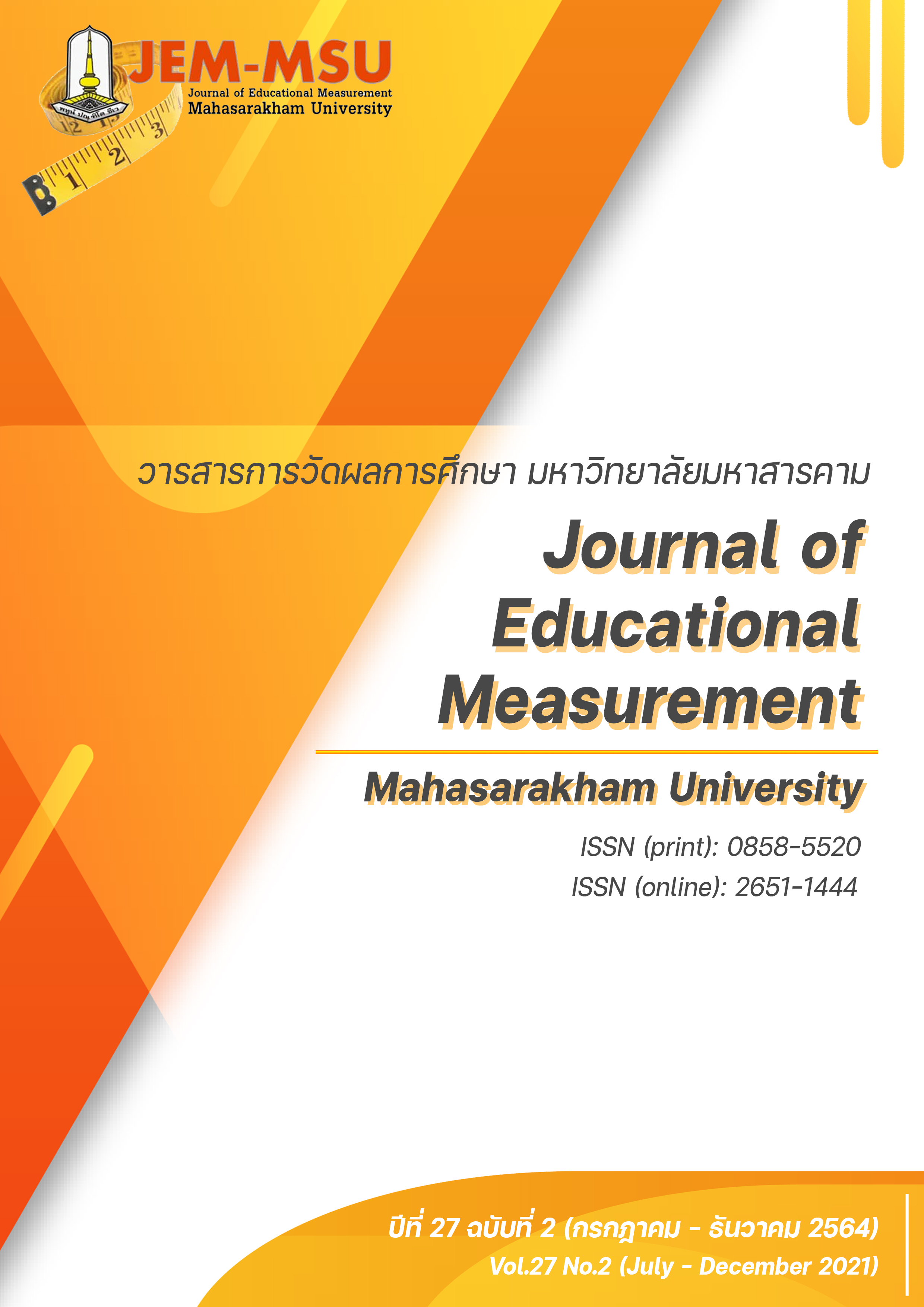Development of Safety Behavior Scale of Lower Secondary School Students
Main Article Content
Abstract
The objectives of this research were to 1) build a safety behavior scale for lower secondary school students, 2) find the quality of the safety behavior scale for lower secondary school students, 3) assess the safety behavior of lower secondary school students. The sample consisted of 1440 lower secondary school students in the schools under the Office of Basic Education Commission in the Upper Northeast, Thailand. The research instrument was a safety behavior scale for lower secondary school students, which was an ordered-multiple choice questionnaire. The data analysis employed frequency, the mean and percentage, estimation 2 parameters of IRT. The cut-off scores of scales were developed by using the criterion zone. The research findings were as follows: 1) The safety behavior scale for the students that had been constructed was a 3-choice type, with multi-scoring options. It was composed of 3 dimensions: cognitive dimension, psychomotor dimension and affective dimension. Each dimension contained 16 items according to the structural map, having the IOC from 0.57 to 1.00, the discrimination from 0.21 to 0.69 and the reliability of 0.82, 0.75 and 0.72 respectively. 2) In the safety behavior scale for the students that had been constructed, 35 items had the quality according to the Item Response Theory. The cognitive dimension had 12 common slope parameters ranging from 0.50 to 0.73; the psychomotor dimension had 11 common slope parameters ranging from 0.53 to 0.75; and the affective dimension had 12 common slope parameters ranging from 0.50 to 1.02. There was no differential item function (DIF) between males and females. The cut-off scores of the safety behavior scale derived from analyzing the criterion zone, consisting of 3 levels of safety behavior as follows: level 1 had the level of competency () = -1.47 down, level 2 had the level of competency (
) =-1.47 to 0.78, and level 3 had the level of competency (
) = 0.78 up. 3) The results of the safety behavior assessment for lower secondary school students, on the whole, were at a moderate level, representing 70.70 percent. When considered by dimension, it was found that in the cognitive dimension most of the students had safety behaviors at a moderate level, representing 78.82 percent; in the psychomotor dimension, the safety behavior was at a moderate level, representing 67.92 percent; and in the affective dimension, the safety behavior was at a moderate level, representing 76.60 percent.
Article Details
The content and information contained in the published article in the Journal of Educational Measurement Mahasarakham University represent the opinions and responsibilities of the authors directly. The editorial board of the journal is not necessarily in agreement with or responsible for any of the content.
The articles, data, content, images, etc. that have been published in the Journal of Educational Measurement Mahasarakham University are copyrighted by the journal. If any individual or organization wishes to reproduce or perform any actions involving the entirety or any part of the content, they must obtain written permission from the Journal of Educational Measurement Mahasarakham University.
References
พิภพ วชังเงิน. (2547). พฤติกรรมองค์การ. กรุงเทพฯ : รวมสาส์น.
ศรัญญา บุญประกอบ. (2549). การศึกษาการจัดบริการความปลอดภัยในโรงเรียนอนุบาลเอกชน เขตวัฒนา กรุงเทพมหานคร. วิทยานิพนธ์ กศ.ม. : มหาวิทยาลัยศรีนครินทรวิโรฒ กรุงเทพฯ.
ศิริชัย กาญจนวาสี. (2555). ทฤษฎีการทดสอบแนวใหม่. พิมพ์ครั้งที่ 4. กรุงเทพฯ: โรงพิมพ์แห่งจุฬาลงกรณ์มหาวิทยาลัย.
ศิริชัย กาญจนวาสี. (2556). ทฤษฎีการทดสอบแบบดั้งเดิม. พิมพ์ครั้งที่ 7. กรุงเทพฯ : โรงพิมพ์แห่งจุฬาลงกรณ์มหาวิทยาลัย.
เอมอัชฌา วัฒนบุรานนท์. (2548). ความปลอดภัย. กรุงเทพฯ : สำนักพิมพ์โอเดียนสโตร์.
Crowe and James, W. (1995). Safety values and safety practices among college student. Journal of Safety Research, 60, 187-195.
De Melo, R. L. P., Da Silva Júnior, E.G., Souto, R. Q., Leão, I. S., and Do Carmo Eulálio, M. (2018). Psychometric properties of the complete version of the World Health Organization Quality of Life Assessment (WHOQOL-OLD): reduced response scale. Psicologia: Reflexão e Crítica, 31(4), 1-10. DOI: 10.1186/s41155-018-0084-1
Denzin, N. K., & Lincoln, Y. S. (2005). Introduction: The Discipline and Practice of Qualitative Research. In N. K. Denzin and Y. S. Lincoln (Eds.), The Sage handbook of qualitative research (p. 1–32). Sage Publications Ltd.
Morizot, J., Ainsworth, A. T., and Reise, S. (2007). Toward modern psychometrics: Application of item response theory models in Personality Research. In R. W. Robins.
O’Connor, B. P., Crawford, M. R., and Holder, M. D. (2015). An Item Response Theory Analysis of the Subjective Happiness Scale. Social Indicators Research, 124, 249–258.
Reckase, M. D. (1979). Unifactor latent trait models applied to multifactor tests: Results and implications. Journal of Educational Statistics, 4(3), 207-230.
Wilson, M., and Sloane, K. (2000). From principles to practice: An embedded assessment system. Applied Measurement in Education, 13(2), 181-208. Retrieved from http://ww2.valdosta.edu/gec/documents/FromPrinciplestoPractice.pdf


